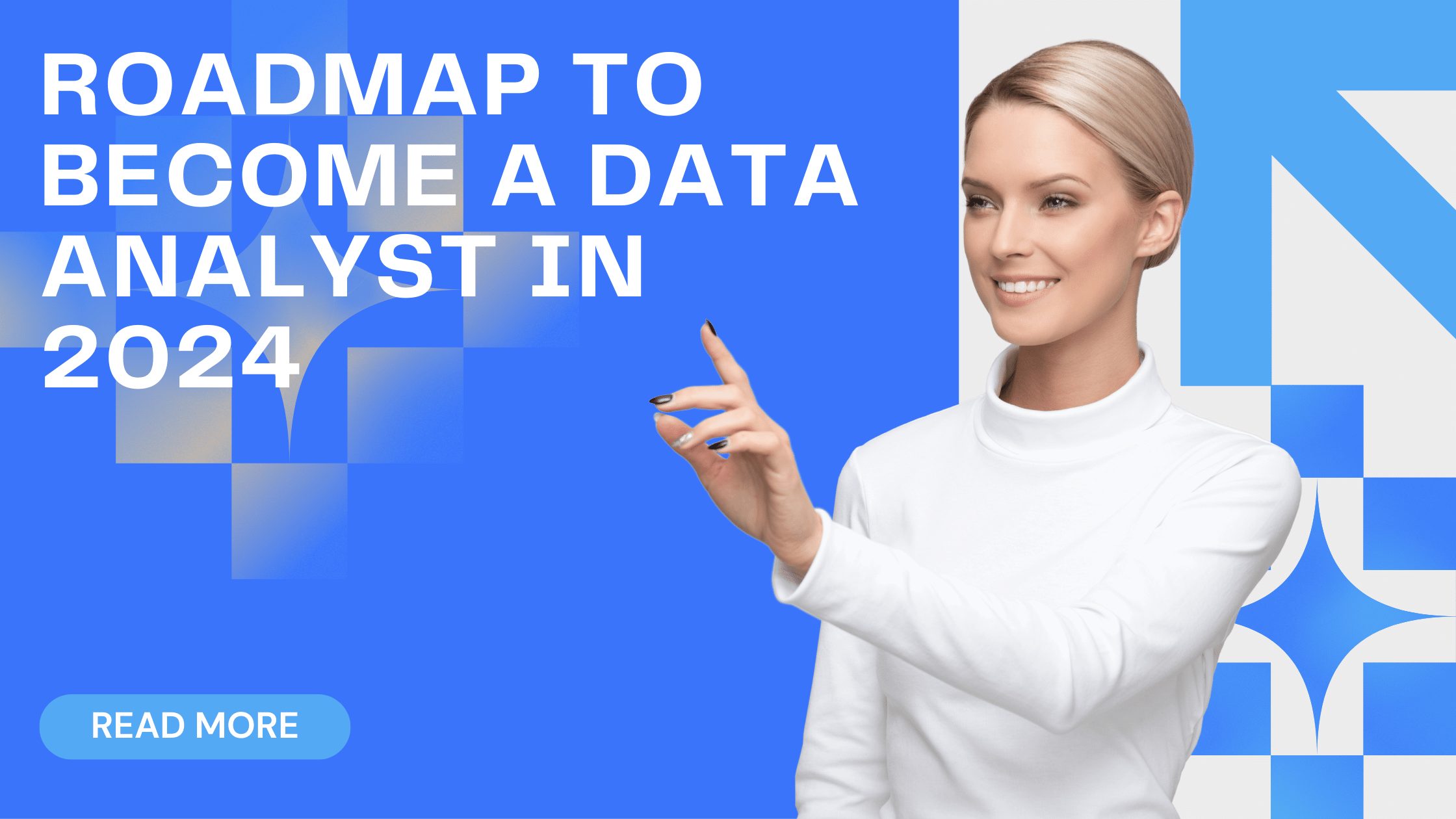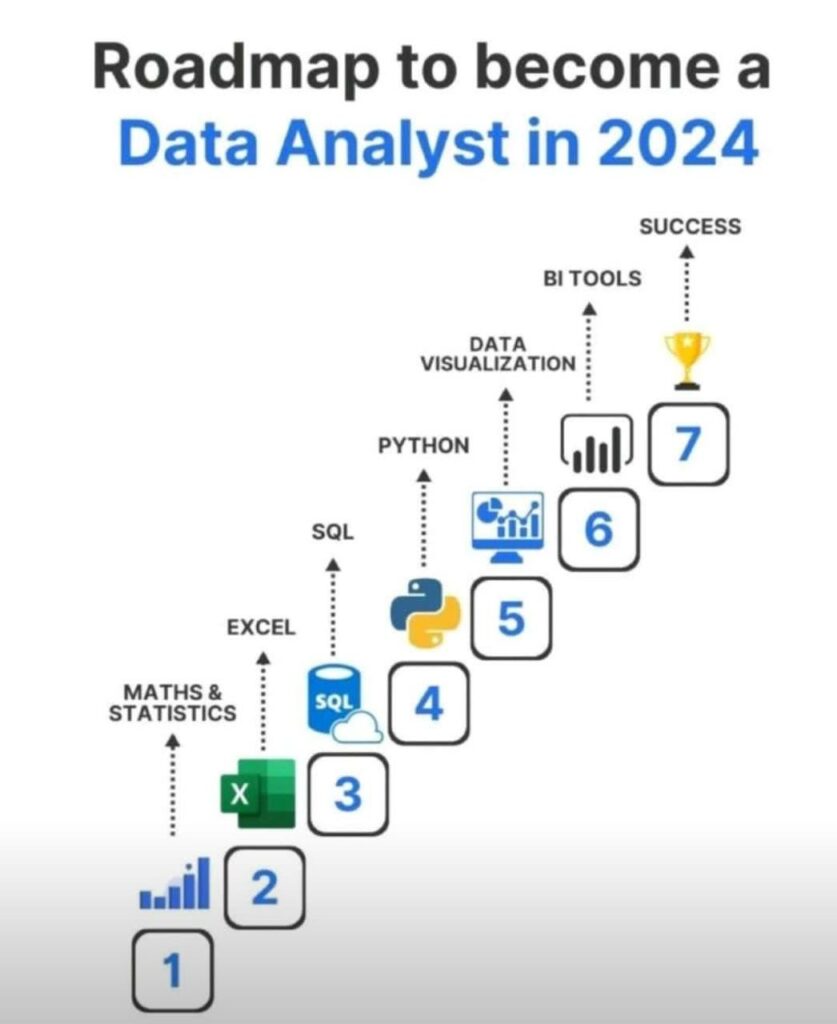


In an era where data is king, the role of a data analyst has become more crucial than ever. As we step into 2024, Allytech presents a meticulous roadmap tailored for aspiring data analysts. This comprehensive guide covers everything from fundamental mathematical principles to advanced data visualization techniques, ensuring a well-rounded skill set for success.
In the dynamic world of technology and data, the journey to becoming a data analyst is both exciting and challenging. As we embark on 2024, the landscape of data analysis continues to evolve, demanding a combination of diverse skills and up-to-date knowledge. This is where Allytech steps in, offering a meticulously crafted roadmap tailored for aspiring data analysts. This guide is more than just an instructional manual; it’s a blueprint for success in the ever-expanding field of data analytics.

We will navigate through the essential skills required in the modern data environment – from the foundational mathematics and statistics to the nuanced realms of Excel, SQL, Python, data visualization, and BI tools. Each section of this roadmap is designed to not only equip you with theoretical knowledge but also to provide practical insights and real-world applications, ensuring that you are industry-ready. By following Allytech’s roadmap, you will be poised to not only enter the world of data analysis but to excel in it, transforming data into insights and insights into impactful decisions. Join us on this journey to transform your passion for data into a thriving career in 2024.
Mathematics and statistics are not merely a part of the data analyst’s toolkit; they are the very essence of understanding and interpreting data. In the vast and varied landscape of data analysis, these disciplines provide the necessary foundation for extracting meaningful insights from raw data. They enable analysts to discern patterns, understand relationships, and make predictions based on empirical evidence.
In this digital age, where data is abundant and ubiquitous, the ability to analyze and interpret this data effectively is invaluable. Maths and statistics empower analysts to transform complex and often chaotic information into actionable insights. Whether it’s calculating the average sales for a quarter, assessing the probability of an event, or determining the correlation between two variables, these skills are integral to making informed, data-driven decisions.
Starting your journey into maths and statistics can be as accessible as enrolling in online courses. There are a wide range of courses tailored for beginners. These courses often include:
The advantage of online courses is their flexibility and the breadth of resources available. Many of these courses are self-paced, allowing learners to progress according to their own schedules and revisit complex topics as needed.
Once the basics are mastered, advancing your knowledge through more specialized classes is crucial. This could involve:
These classes are often available through the same online platforms but are also offered by universities and colleges as part of their continuing education programs. They provide a more rigorous and structured approach to learning, often including assignments, projects, and exams to test and solidify your understanding.
There is no substitute for practical experience. Applying the concepts learned in real-world scenarios is crucial for cementing your knowledge and skills in maths and statistics. This can be achieved through:
Hands-on projects not only enhance your understanding of mathematical and statistical concepts but also help build a portfolio that can be showcased to potential employers. They provide practical experience in problem-solving and analytical thinking – skills that are highly valued in the field of data analysis.
Microsoft Excel, a tool familiar to many, extends far beyond its common use as a spreadsheet application. In the world of data analysis, Excel is a powerhouse, offering a range of functionalities that can transform raw data into insightful information. This section of the guide focuses on Excel’s pivotal role in data analytics, highlighting its capabilities and versatility. From basic data organization to complex analytical tasks, Excel remains an indispensable tool for analysts in 2024.
Excel’s utility in data analysis lies in its array of features that cater to various needs. Key functionalities include data cleaning and formatting, which are essential first steps in any data analysis process. Excel’s formulae and functions allow for efficient data manipulation, calculation, and transformation. PivotTables, one of Excel’s most powerful features, enable quick data summarization and analysis, allowing analysts to discover patterns and insights from large datasets. Furthermore, Excel’s charting tools provide a means to visualize data, making it easier to communicate findings and trends.
The journey to mastering Excel often begins with comprehensive tutorials. Platforms like LinkedIn Learning and Udemy offer a range of courses tailored to different expertise levels. For beginners, these tutorials cover the basics such as navigating the interface, understanding cell functions, and basic formulas. Intermediate courses delve into more complex functions, data validation, and conditional formatting. Advanced tutorials explore dynamic formulas, array functions, and advanced charting techniques.
The key advantage of these online tutorials is their structured learning path, often accompanied by practical exercises, quizzes, and real-world examples. This approach ensures a deeper understanding of Excel’s functionalities and their applications.
Practical application of learned skills is crucial. Applying Excel skills to real-world data sets is one of the most effective ways to gain proficiency. This could involve:
Working with actual data sets from various domains not only enhances Excel skills but also provides insights into how data analysis is applied in different industries.
To truly leverage Excel in data analytics, one must delve into its advanced features. PivotTables are incredibly powerful for data analysis, enabling users to dynamically rearrange and summarize large amounts of data. Learning to use PivotTables effectively can significantly enhance one’s ability to make data-driven decisions.
Visual Basic for Applications (VBA) scripting in Excel opens doors to automation. Learning VBA allows analysts to automate repetitive tasks, create custom functions, and develop interactive tools within Excel. This can be particularly useful in streamlining workflows and enhancing the efficiency of data analysis processes.
In the world of data analytics, SQL (Structured Query Language) stands as an essential skill. It’s the primary language used for interacting with and managing databases. For data analysts, proficiency in SQL is not just beneficial; it’s a necessity. SQL allows analysts to efficiently extract, update, manipulate, and analyze data stored in relational databases. Its importance is underscored by the fact that most of the world’s data is stored in databases that require SQL for access and analysis.
SQL’s power lies in its ability to handle large volumes of data, perform complex queries, and interact with multiple databases simultaneously. This makes it an invaluable tool for data analysts who need to retrieve specific information from vast and intricate datasets quickly. Understanding SQL enables analysts to derive meaningful insights from data that would be otherwise inaccessible.
The journey to mastering SQL begins with understanding the basics. Online learning platforms like Codecademy and Udemy offer beginner courses that introduce the fundamental concepts of SQL. These courses typically cover:
These introductory courses are designed to build a solid foundation, upon which more advanced SQL skills can be developed.
Once the basics are grasped, the next step is to delve into more complex aspects of SQL. This includes learning how to:
Courses aimed at intermediate and advanced learners often include real-world scenarios, providing a practical context for the more complex features of SQL.
The best way to solidify SQL skills is through practical application. Implementing SQL in personal projects or volunteering for tasks that require database interaction is highly beneficial. This could involve:
These real-world experiences reinforce the learned concepts and demonstrate the practical utility of SQL in various contexts.
In recent years, Python has emerged as the language of choice for data analysts. Its simplicity, versatility, and the extensive range of libraries dedicated to data analysis make it an invaluable tool in the analyst’s arsenal. Python’s syntax is intuitive and readable, which makes it accessible to beginners and experienced programmers alike. This segment explores why Python has become so dominant in data analytics and offers a structured path for mastering it.
Python excels in various aspects of data analysis, including data manipulation, statistical analysis, machine learning, and data visualization. Libraries like Pandas and NumPy simplify complex data operations, while Matplotlib and Seaborn provide powerful visualization capabilities. The language’s ability to integrate with other tools and technologies, such as SQL databases and Excel files, further enhances its utility in the data analytics field.
The first step in learning Python is to understand its basic programming concepts. Beginners should start with introductory Python courses that cover fundamental topics such as:
Online platforms like Codecademy, Udemy, and Coursera offer beginner-friendly courses that provide interactive learning experiences. These platforms often include hands-on exercises and projects, enabling learners to apply what they have learned immediately.
Once the basics are grasped, the next step is to delve into Python’s data-specific libraries. Pandas and NumPy are essential for data manipulation and analysis. Learning these libraries involves:
Advanced courses and tutorials, often available on the same platforms, provide in-depth knowledge and practical examples to master these libraries.
Practical application is key to mastering Python for data analysis. Engaging in real-world projects allows you to apply your skills and gain valuable experience. Project ideas include:
These projects not only reinforce your Python skills but also help in building a portfolio that showcases your ability to apply Python in practical data analysis scenarios.
Data visualization is not just a part of data analysis; it’s a crucial aspect that brings data to life, making complex information understandable and engaging. The ability to effectively visualize data allows analysts to tell stories, highlight trends, and make data-driven arguments more persuasive. This chapter focuses on the importance of data visualization, best practices, and the tools necessary for creating powerful visual narratives.
The art and science of data visualization involve translating numerical data into visual formats, such as charts, graphs, and interactive dashboards. This process is key in making data accessible to a wide range of audiences, including those who might not have deep technical expertise. Good visualizations can reveal insights and patterns in data that might be missed in traditional reports or raw numbers.
To start mastering data visualization, one must first become familiar with the leading tools in the field. Tableau and PowerBI are among the most popular and powerful data visualization tools currently available. They offer a wide range of functionalities to create comprehensive and interactive visualizations.
Both tools have free versions or trials available, making it easy for beginners to start experimenting with data visualization.
Understanding the principles of effective data visualization is as important as learning the tools. Online platforms like Coursera, Udemy, and edX offer courses that cover these principles. These courses often include:
These courses are often taught by industry professionals and provide not just theoretical knowledge but also practical tips and examples.
The best way to learn data visualization is by doing. Start by visualizing different types of data – sales figures, customer data, market research, etc. Try to use a variety of charts and formats to find what works best for each type of data.
Seeking feedback on your visualizations is crucial. Share your work with peers, mentors, or online communities. Constructive feedback will help you understand what makes a visualization effective or ineffective.
Participating in online challenges or competitions, such as those hosted on Kaggle, can also provide valuable experience. These platforms offer real-world datasets and challenges, providing an opportunity to practice and showcase your visualization skills.
The landscape of data analysis is rapidly evolving, and at its forefront are Business Intelligence (BI) tools. These tools are crucial for transforming raw data into actionable insights, making them indispensable for informed decision-making in businesses. The power of BI tools lies in their ability to aggregate, analyze, and visualize large amounts of data efficiently, helping organizations identify trends, spot opportunities, and make strategic decisions based on data.
In this chapter, we explore the significance of BI tools in modern data analytics and offer a roadmap to acquiring proficiency in these essential tools. Understanding and mastering BI tools like Tableau, PowerBI, and Qlik can set a data analyst apart in their ability to provide comprehensive business solutions.
The first step in mastering BI tools is to explore and understand the functionalities of popular platforms:
Each of these tools has distinct features and strengths, making them suitable for various business intelligence needs. Familiarizing yourself with these tools involves experimenting with their features and understanding their application in different scenarios.
While self-exploration is beneficial, structured learning can significantly accelerate the mastery of BI tools. Many online platforms and educational institutions offer specific courses for each BI tool. These courses typically cover:
These courses are often project-based, providing hands-on experience and practical knowledge, which is crucial for understanding the full capabilities of these tools.
Theoretical knowledge and practical skills go hand in hand. Applying BI tools in real-world scenarios is essential for mastering their use. This can be achieved through:
Applying BI tools in real-world scenarios helps in understanding the challenges and nuances of data analysis in a business context. It provides insight into how data-driven strategies are developed and executed, which is invaluable for any aspiring data analyst.
In the dynamic and fast-paced field of data analysis, selecting the ideal educational institute is a critical step for aspiring professionals. AllyTech distinguishes itself as a top-tier choice for those embarking on a data analytics career path. This institution stands out for its comprehensive approach and dedication to student success, making it an exemplary destination for budding data analysts.
AllyTech’s curriculum is crafted to reflect the latest industry standards and emerging trends. The courses encompass a broad range of essential subjects, including mathematics and statistics, programming languages such as Python and SQL, along with extensive training in Business Intelligence (BI) tools and data visualization technologies. This all-encompassing curriculum ensures that graduates are not only academically well-versed but also fully prepared for the demands of the industry.
AllyTech sets itself apart with its focus on practical, experiential learning. Recognizing the importance of real-world experience, the institute integrates case studies, hands-on projects, and simulations of real-world scenarios into its curriculum. This approach allows students to apply theoretical knowledge in practical, real-world contexts.
At AllyTech, the faculty is comprised of seasoned industry professionals who bring a wealth of practical experience and insights to the classroom. These expert instructors provide a rich, knowledge-intensive learning experience that is grounded in real-world application.
The institute’s robust connections with leading companies and industry experts offer students unparalleled networking opportunities. These connections often lead to internships, mentorships, and job placements, providing AllyTech students with a competitive edge in the job market.
AllyTech is equipped with modern learning facilities and resources, including advanced computer labs, an extensive digital library, and access to the latest in data analysis software and tools. These facilities enhance the overall learning experience and prepare students for the technological environments they will encounter in their careers.
AllyTech is dedicated to the continuous development of its students, a commitment that extends beyond the completion of their courses. The institute offers ongoing learning resources, workshops, and seminars, as well as access to a supportive alumni network and career services, ensuring its graduates continue to grow and thrive in their careers.
For those aiming to excel in the field of data analytics, selecting the right educational institute is a crucial decision. AllyTech emerges as a preeminent choice, offering a comprehensive educational experience that combines a rigorous curriculum, expert faculty, and superior resources. Its emphasis on practical learning, industry relevance, and ongoing support establishes AllyTech as an exceptional institution for aspiring data analysts seeking to make a significant impact in the world of data.





